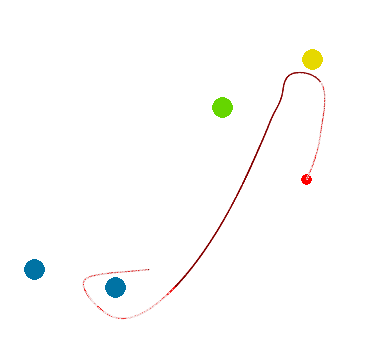Community Tip - Want the oppurtunity to discuss enhancements to PTC products? Join a working group! X
- Subscribe to RSS Feed
- Mark Topic as New
- Mark Topic as Read
- Float this Topic for Current User
- Bookmark
- Subscribe
- Mute
- Printer Friendly Page
The movement of the body around the mass problem!
- Mark as New
- Bookmark
- Subscribe
- Mute
- Subscribe to RSS Feed
- Permalink
- Notify Moderator
The movement of the body around the mass problem!
hi
I found a book in the movement of the planets around the masses. Rewrote all of the books but does not want to work. I would also like to make this move planets with animate to.
Solved! Go to Solution.
- Labels:
-
Other
Accepted Solutions
- Mark as New
- Bookmark
- Subscribe
- Mute
- Subscribe to RSS Feed
- Permalink
- Notify Moderator
Please, find Odesolve command in your sheet. You wrote vector as x,y,x, but it must be x,y,z.
- Mark as New
- Bookmark
- Subscribe
- Mute
- Subscribe to RSS Feed
- Permalink
- Notify Moderator
Please, find Odesolve command in your sheet. You wrote vector as x,y,x, but it must be x,y,z.
- Mark as New
- Bookmark
- Subscribe
- Mute
- Subscribe to RSS Feed
- Permalink
- Notify Moderator
See attached.
Changed parameter in Create Space and type of graph from surface to scatter.
Look what happens if you change the interval in odesolve (from 1 to3 or greater)
Thanks to rosenm for finding the typo.
- Mark as New
- Bookmark
- Subscribe
- Mute
- Subscribe to RSS Feed
- Permalink
- Notify Moderator
- Mark as New
- Bookmark
- Subscribe
- Mute
- Subscribe to RSS Feed
- Permalink
- Notify Moderator
A description, esp. the meaning of your vars and functions wouls have been helpful.
Is F(t) a vector describung the position of moving a fifth planet (with mass 0???)
Does the attched help?
BTW, Freemake Video Converter did the job well. THnaks again.
- Mark as New
- Bookmark
- Subscribe
- Mute
- Subscribe to RSS Feed
- Permalink
- Notify Moderator
If he was still visible lane 5 planet that would be great.![]() The fifth planet has a mass very much less (close to zero) from 4 others.
The fifth planet has a mass very much less (close to zero) from 4 others.
- Mark as New
- Bookmark
- Subscribe
- Mute
- Subscribe to RSS Feed
- Permalink
- Notify Moderator
Jan Kowalski schrieb:
If he was still visible lane 5 planet that would be great.

So why don't you add the path of the fifth planet? ![]()
I am not sure if that animations reflects real situation. What happens at 00:27/00:28 ? Bouncing back from the yellow planet or are we going round that planet so quickly that the animation did not catch it?
- Mark as New
- Bookmark
- Subscribe
- Mute
- Subscribe to RSS Feed
- Permalink
- Notify Moderator
The odesolve is the previous value was inaccurate. You have to increase the number of step intervals. Or something like that.
Werner ,rosenm Thanks for your replay.
- Mark as New
- Bookmark
- Subscribe
- Mute
- Subscribe to RSS Feed
- Permalink
- Notify Moderator
What happens here? It looks like the red "planet" is rejected by the yellow one.
Shown is the path between t=260 and t=276.

- Mark as New
- Bookmark
- Subscribe
- Mute
- Subscribe to RSS Feed
- Permalink
- Notify Moderator
Try to enter the values shown by arrows(file.gif).Odesolve solves the equation in an approximate manner. The higher the number (intvls) the more accurate solution.
Odesolve([vector], x, b, [intvls])
- b is the real terminal point of the integration interval. b can be greater than or less than the initial value, which is inferred from the initial conditions in the solve block.
- intvls (optional) is the integer number of discretization intervals used to interpolate the solution function. The number of solution points is the number of intvls + 1. The default value of intvls is 1000. More is more accurately eg: 50000
in our case it b=500,intvls=20000.
- Mark as New
- Bookmark
- Subscribe
- Mute
- Subscribe to RSS Feed
- Permalink
- Notify Moderator
I left b at 400 but the change of the intervals of odesolve does significantly affect the path of that planet. Decent accuracy is achieved by intervals>10^5. But then, solving an DE from 0 to 400 (!!) numerically is quite a task.
Attached the change of the path (t=260 to t=276) when changing the intervals of odesolve from 10^3 to 10^6.
At least it shows the the red planet goes around the yellow one as it should be.
- Mark as New
- Bookmark
- Subscribe
- Mute
- Subscribe to RSS Feed
- Permalink
- Notify Moderator
See the example of how the function changes it, odesolve accuracy by changing the step parameter.
see file attached.
- Mark as New
- Bookmark
- Subscribe
- Mute
- Subscribe to RSS Feed
- Permalink
- Notify Moderator
Significant, indeed. An the interval we are calculating the solution for is only from 0 to pi, not from 0 to some hundreds as we did with the planets.
- Mark as New
- Bookmark
- Subscribe
- Mute
- Subscribe to RSS Feed
- Permalink
- Notify Moderator
- Mark as New
- Bookmark
- Subscribe
- Mute
- Subscribe to RSS Feed
- Permalink
- Notify Moderator





